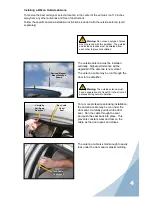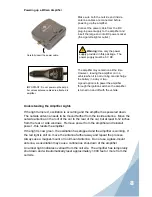
Wilson
®
Electronics, Inc.
Phone: 866-294-1660
www.wilsonelectronics.com
Fax: 435-656-2432
Part #110526 AIG SBoostMW 004 / 02.27 08
Amplifier Specifications
Dual Band
800/1900 MHz Specifications
Model Number / Part Number
271230/801230
Connectors
SMA Female
Impedance (input/output)
50 ohms
Dimensions
3.8 X 3.2 X 1.5 inch or 9.6 X 8.1 X 3.8 cm
Weight
4 oz or 0.11 kg
Frequency
824-894 MHz / 1850-1990 MHz
1
Passband Gain (nominal)
800 MHz uplink
38 dB (typical) / 43 dB (maximum)
800 MHz downlink
40 dB (typical) / 51 dB (maximum)
1900 MHz uplink
44 dB (typical) / 53 dB (maximum)
1900 MHz downlink
46 dB (typical) / 53 dB (maximum)
2
20 dB Bandwidth (nominal)
800 MHz (uplink/downlink)
32 MHz / 32 MHz
1900 MHz (uplink/downlink)
77 MHz / 74 MHz
Power output for single cell phone (uplink)
800 MHz
1900 MHz
CDMA
31.9 dBm
31.9 dBm
GSM
29.6 dBm
30.3 dBm
EDGE
30.3 dBm
30.9 dBm
AMPS
29.3 dBm
3
Power output (uplink) for multiple
cell phones:
Number of
cell phones
Maximum Power
800 MHz
1900 MHz
2
25.1 dBm
23.2 dBm
3
21.5 dBm
19.7 dBm
4
19.0 dBm
17.2 dBm
5
17.1 dBm
15.3 dBm
6
15.5 dBm
13.7 dBm
Power output for single received channel (downlink)
800 MHz
1900 MHz
CDMA
18.3 dBm
13.8 dBm
GSM
18.1 dBm
14.1 dBm
EDGE
18.4 dBm
12.0 dBm
AMPS
12.0 dBm
4
Power output for multiple received
channels (downlink).
The maximum
power is reduced by the number of
channels:
Number of
channels
Maximum Power
800 MHz
1900 MHz
2
15.1 dBm
8.3 dBm
3
11.6 dBm
4.8 dBm
4
9.1 dBm
2.3 dBm
5
7.2 dBm
0.3 dBm
6
5.6 dBm
-1.3 dBm
Noise Figure (typical)
3 dB nominal
Isolation
> 90 dB
Power Requirements -
Amplifier Usage
6 V, 0.6A - 2A (subject to uplink power)
Notes:
1. Nominal gain is the maximum gain at any frequency in the passband.
2. Nominal bandwidth is the difference between two frequencies that are adjacent to the passband where the amplification is 20 dB
lower than the passband amplification. One of the frequencies is lower than the passband and the other is higher.
3. The Manufacturer’s rated output power of this equipment is for single carrier operation. For situations when multiple carrier
signals are present, the rating would have to be reduced by 3.5 dB, especially where the output signal is re-radiated and can
cause interference to adjacent band users. This power reduction is to be by means of input power or gain reduction and not by
an attenuator at the output of the device.
4. The maximum power for 2 or more simultaneous signals will be reduced by 6 dB every time the number of signals is doubled.






























